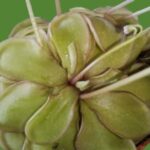As an Amazon Associate, this site earns commissions from qualifying purchases. For more details, click here.
You have been admiring your sundew for a while, but now you see the leaves have turned black. Any time leaves turn brown or worse black is not a good sign, right? Fortunately all is not lost for your plant. This article reveals the possible causes and solutions.
Sundew leaves usually turn black for two reasons: stress or exposed to too much sunlight. If you recently bought a sundew, the plant might be adjusting to its new environment, so give it a few weeks to acclimatize.
Reason 1: Too Much Heat and Light
Sundews need sunlight and warmth to grow, but too much can burn its leaves, turning them brown or black. Aside from the color, burnt leaves have a crispy texture and are completely dry.
Black or brown sundew leaves are also hot to the touch. This is another indication the plant has been exposed to too much light and heat. This situation occurs during summer especially if you live in a dry, arid location with low humidity.
If you are not sure of the temperature range, check your hardiness zone. This will help you determine if the weather outside is suitable for your sundew.
How to Protect Sundews From Heat
Most sundews prefer high humidity and a temperature range between 45 to 85 F (7.2 to 29.4 C). Direct or indirect light will not be a problem as long as it is not too hot.
The best solution is to move your sundew under shade. If the plant is outdoors, you can either find shade or take it inside.
When the temperature drops to around 85 F (29.4 C), bring the sundew back to its original location. Do not worry if the black leaves die as new, healthy ones will take their place.
Although it is possible to revive a dying sundew, it is better to take preventive steps. In this case, protect the plant from excessive heat.
Should You Bring Sundews Inside to Avoid Intense Heat?
Moving the plant inside might cause stress due to the change in humidity, temperature etc. A better option would be to keep the plant outdoors, but find a spot where direct sunlight and heat cannot reach the plant.
If you decide to bring the sundew indoors, place it on a windowsill so the leaves can still receive light. Provide shade if necessary but do not deprive the plant of light.
Bottom line: if you decide to bring your sundew inside, make certain it receives enough light, nutrients and water. Water in particular is important during summer so be generous with the amount. While you can overwater sundews , they can handle lots of it especially during the dry season.
Sundews may also brought indoors during intense cold, and the same rules apply. You do not want the plant to freeze to death but when indoors keep it in a cool location. This is especially true if your sundew goes dormant.
Can You Use Artificial Light on Sundews?
Artificial light may be used to grow sundews indoors. Use a fluorescent light and place it 6 inches above the plant. Keep the light on for 14-16 hours a day.
Do not position the light too close to the plant as it could burn the leaves. Even soft lighting can burn sundew leaves if it is too close. The higher the intensity the hotter it gets for the plant, so keep the fixture at a distance of six inches. There are a lot of lights available, but one of the best is GroDrow because it is made for thee plants.
Sundews prefer natural light, but if that is not possible artificial light fixtures will do. If your sundew is always indoors, the lighting should approximate the hours the plant would receive if it were outdoors. For winter that is 12 hours, spring 14 hours and summer 16 hours.
Those lighting hours are general guidelines only. Even indoor plants can receive sunlight if you place it on an open window. It is the total amount of light that matters.
Reason 2: Stress
If you just bought a sundew or thinking of buying one, do not be surprised if brown or black leaves suddenly appear. The plant is suffering from stress due to the change in environment.
Sundews are sensitive to temperature, humidity, air circulation and light. The conditions in your home will be completely different from the store where you bought it.
Some sundews adjust quickly. But others need more time, especially if it came from a high humidity area and goes to one that is dry, with high temperatures and too little or too much light. The reverse – low humidity to high humidity – can also be stressful. Stress can be fatal to plants but if it is healthy, will get used to your home.
How to Help Sundews Acclimatize to Your Home
The best way to approach this situation is to help your new sundew acclimatize. There are four things sundews have to get used to: the humidity, lighting and the temperature.
Step 1: Humidity
Your new sundew plant comes in a sealed container. Do not throw the box away yet. Bring the box inside and open it for a few hours. This gives the plant time to get used to the humidity in your home. You can also do this outdoors if your plant will be placed outside.
If you have ever brought plants indoors during winter, you have probably done something similar. You get it slowly used to the indoor temperature so it does not get stressed. The same rule applies when getting a sundew used to humidity.
Step 2: Light and Temperature
Leave your sundew by a window for several days and see what happens. If the leaves turn black or brown, the plant cannot stand the heat.
Remove it from the window and place it under shade. You can put it anywhere as long as it does not receive direct sunlight. If the leaves are turning black or brown, indirect light is the best option.
Once the plant is under shade, observe it again for a couple of weeks. It should discard the black and brown leaves and grow healthy ones. Once the plant is healthy again, reduce its shading little by little.
Again you have to keep an eye on the temperature. If it gets too hot and the leaves go black, move the sundew under shade. Some variants can handle heat well so look at the leaves for clues. As long as they do not turn black or brown, the sundew is fine.
Other Possible Causes of Black Sundew Leaves
While too much sunlight and stress are the most likely reasons for black sundew leaves, we cannot discount other possibilities. If the leaves turn black and you have ruled out too much light and stress, consider the following.
Pests. Sundews eat aphids, but these bugs can cause an infestation. You need to remove these pests as soon as possible. Aside from aphids, mealy bugs and spider bugs are other common sundew pests.
The simplest way to deal with this problem is to use an insecticide. Make sure though the spray is safe to use on sundews. Buy from reputable brands only like BIOADVANCED Insect Spray which is proven safe for all kinds of plants.
Infection. Bacterial or fungal infection may also cause the leaves to go black or brown. However, an infected sundew has other symptoms such as root rot, mushy stems, lack of dew, refusal to eat etc.
If all you see are dry, black or brown leaves, the plant is probably not infected. But keep an eye for other symptoms just in case.
Dormancy. When sundews go into dormancy, they lose their leaves and look all but dead. However, the leaves usually turn brown, not black. But it can be difficult to tell so look at the plant carefully. If the leaves start going black around fall and that sundew is known to go into dormancy, then there is nothing to worry about.
Conclusion
Seeing sundew leaves turn black can be alarming, but there is no need to panic. You have to take action, but as explained here the solution is usually simple. If you follow these tips you should be able to take care of your sundew and they will be free of black leaves.

My fascination with carnivorous plants began many, many years ago with Venus Fly Traps. Now I am more than happy to impart what I know with other enthusiasts and those who are curious about meat eating plants.



